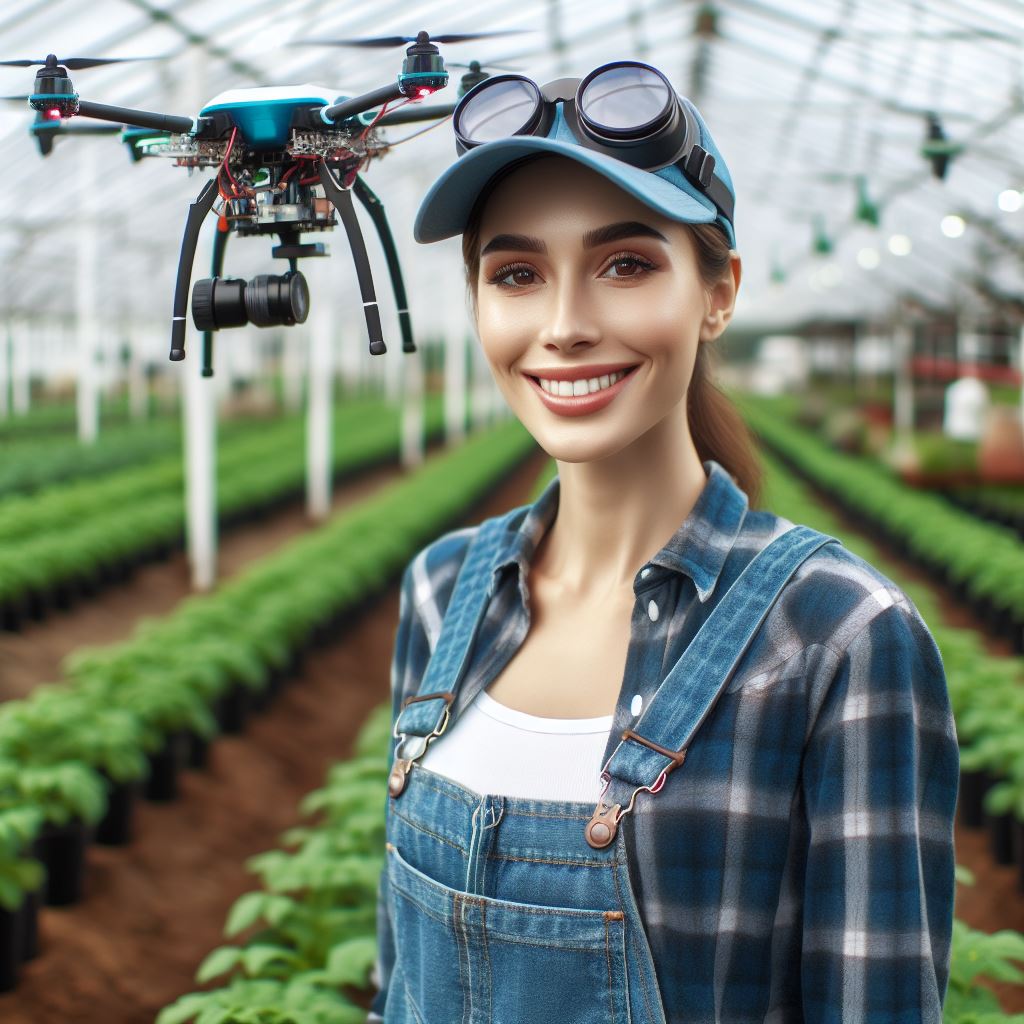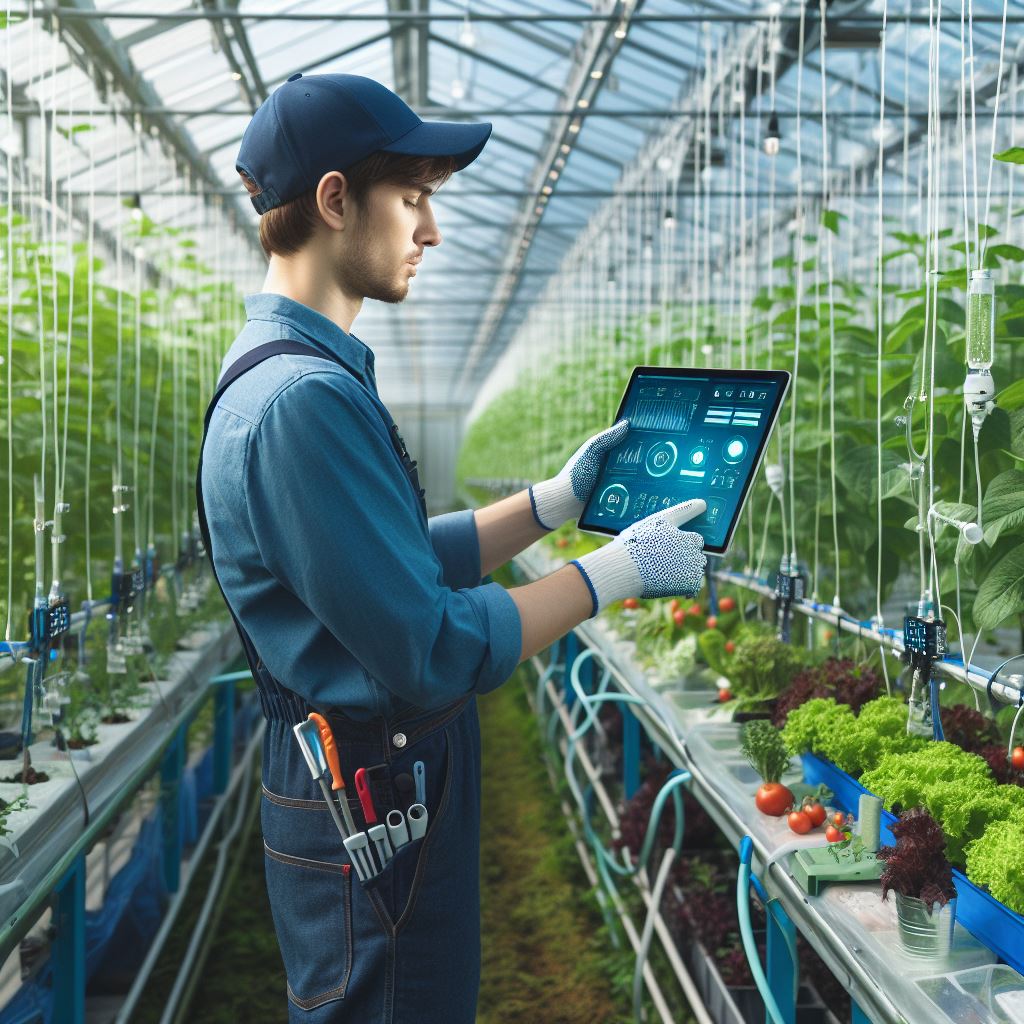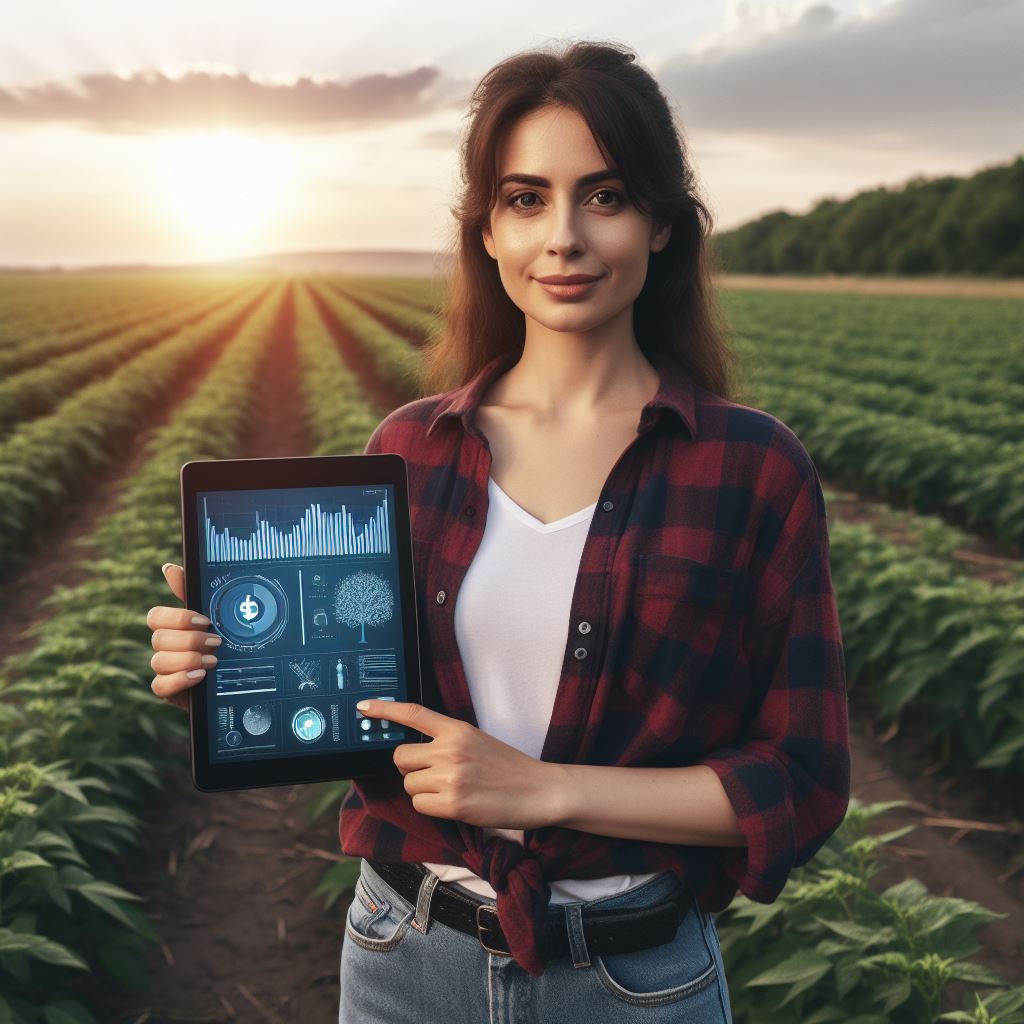Introduction
Agricultural drones, also known as unmanned aerial vehicles (UAVs), are revolutionizing the way farming is done.
These small aircraft equipped with imaging capabilities and sensors can be used to monitor crops, livestock, and other agricultural activities.
The use of drones in farming is gaining popularity due to the numerous benefits they offer.
The importance of agricultural drones in modern farming cannot be overstated.
They allow farmers to gather real-time data about their crops, such as plant health, moisture levels, and pest infestations.
This information helps farmers make informed decisions, optimize crop management, and ensure maximum yield.
Agricultural drones are also widely used for aerial spraying of pesticides and fertilizers.
They can cover large areas quickly and accurately, minimizing chemical wastage and reducing the potential harm to human health and the environment.
This precise application of inputs increases the effectiveness of pest and disease control, resulting in healthier crops.
Moreover, drones can be used to monitor livestock, making it easier to detect and manage their behavior, health, and well-being.
They can capture high-resolution images and videos, enabling farmers to assess the condition of animals and identify potential issues promptly.
The prevalence of agricultural drones in modern farming is growing rapidly.
More and more farmers are embracing this technology as it improves efficiency, reduces costs, and saves time.
Drones offer a cost-effective solution compared to traditional methods of monitoring and managing agricultural activities.
They can quickly cover large areas of farmland, providing a comprehensive view of the entire field.
In short, agricultural drones have transformed farming by revolutionizing crop monitoring, livestock management, and the application of inputs.
Their importance and prevalence in modern farming practices cannot be underestimated.
As technology advances further, the use of agricultural drones is expected to become even more widespread, benefiting farmers and the entire agricultural industry.
The Benefits of Agricultural Drones
Agricultural drones, also known as unmanned aerial vehicles (UAVs), have revolutionized the farming industry.
With their ability to fly autonomously and collect valuable data, these drones offer numerous benefits to farmers.
In this blog section, we will explore and discuss the advantages of using agricultural drones in modern farming practices.
Increased efficiency and productivity
One of the major benefits of agricultural drones is the increased efficiency and productivity they bring to farming operations.
These drones can cover large areas of farmland quickly, capturing high-resolution images and videos.
This allows farmers to assess the condition of their crops and identify potential issues, such as pest infestations or nutrient deficiencies.
With this information, farmers can take immediate action, leading to more effective and targeted treatments.
The ability to collect more accurate data enhances decision-making processes, ultimately improving productivity and reducing costs.
Precision agriculture and resource management
Precision agriculture and resource management are crucial aspects of modern farming.
Agricultural drones play a vital role in achieving these objectives.
By utilizing drones, farmers can identify specific crop needs more precisely.
With the help of advanced sensors and imaging technologies, drones can analyze crop health, monitor growth patterns, and determine the optimal time for harvesting.
This information enables farmers to apply the right amount of water, fertilizers, and pesticides, minimizing waste and environmental impact.
Additionally, drones facilitate the mapping of farmland, giving farmers a comprehensive view of their fields and helping them make informed decisions about resource allocation.
Crop health monitoring and early detection
Crop health monitoring and early detection of issues are paramount for ensuring successful harvests.
Agricultural drones excel in this aspect by providing a bird’s-eye view of the fields.
They can spot signs of diseases, pests, and nutrient deficiencies that may not be visible at ground level.
The timely detection of such problems allows farmers to take immediate action, preventing further crop losses.
Drones equipped with spectral imaging sensors can even detect subtle variations in crop health, enabling early intervention before the issue becomes severe.
This proactive approach helps farmers maintain the overall health of their crops, resulting in higher yields and profitability.
In general, agricultural drones offer a wide range of benefits for modern farming practices.
They increase efficiency and productivity by quickly covering large areas of farmland and providing accurate data collection.
Precision agriculture is made possible through the identification of specific crop needs and optimal resource management.
Crop health monitoring and early detection of diseases, pests, and nutrient deficiencies enable timely intervention and prevention of crop losses.
With the help of agricultural drones, farmers can enhance their decision-making processes, reduce costs, and achieve higher yields in a sustainable manner.
Types of Agricultural Drones
Agricultural drones come in various types, each designed with specific capabilities and flight characteristics to cater to different farming needs.
Two prominent types that are widely used in the agricultural industry are fixed-wing drones and multi-rotor drones.
Fixed-wing drones
Fixed-wing drones are unmanned aerial vehicles (UAVs) that resemble traditional airplanes.
They have fixed wings, similar to airplanes, which enable them to fly efficiently over extended periods.
These drones can cover large areas quickly due to their high speed and longer flight time, making them ideal for large-scale agricultural operations.
Fixed-wing drones are equipped with advanced mapping and imaging systems, allowing them to collect data from the air.
They can capture high-resolution aerial images, perform remote sensing, and create accurate maps of farmland.
These capabilities enable farmers to monitor crop health, detect diseases, identify areas of irrigation issues, and assess the overall condition of their fields.
Moreover, fixed-wing drones provide valuable insights into the topography and drainage patterns of agricultural land.
This information helps optimize irrigation practices and increase water-use efficiency, resulting in reduced costs and improved crop yields.
With the ability to cover larger areas in a single flight, fixed-wing drones significantly reduce the time and labor required to survey and monitor extensive farmland.
Multi-rotor drones
Multi-rotor drones, also known as quadcopters or hexacopters, are a popular choice for smaller farming operations and precision agriculture.
Unlike fixed-wing drones, they are capable of vertical takeoff and landing, as well as hovering at specific locations.
Multi-rotor drones offer more maneuverability and flexibility, making them suitable for operating in confined spaces.
They can fly at lower altitudes, allowing for detailed inspections of crops, livestock, and infrastructure on the farm.
These drones are equipped with high-resolution cameras, sensors, and even thermal imaging technology.
They can capture detailed images, record videos, and collect data from different perspectives.
Farmers can use this data to assess crop health, identify pest infestations, and apply targeted treatments.
Additionally, multi-rotor drones aid in assessing crop maturity and optimizing harvest timings.
Precision agriculture greatly benefits from multi-rotor drones as they can precisely navigate through crops, capturing valuable data for creating accurate yield maps.
This information helps farmers make informed decisions regarding seeding rates, fertilizer applications, and irrigation strategies, ultimately optimizing productivity and resource utilization.
Transform Your Agribusiness
Unlock your farm's potential with expert advice tailored to your needs. Get actionable steps that drive real results.
Get StartedIn a nutshell, the types of agricultural drones cater to specific farming needs and provide valuable insights within various farming operations.
Fixed-wing drones are ideal for large-scale agriculture, enabling efficient surveillance and mapping capabilities.
On the other hand, multi-rotor drones excel in smaller farming operations and precision agriculture, delivering detailed data for informed decision-making.
The adoption of agricultural drones empowers farmers with accurate information, leading to improved crop health, optimized resource management, and higher yields.
Read: Farming in the Digital Age
Key Features and Technologies of Agricultural Drones
Agricultural drones have revolutionized farming practices by offering numerous key features and advanced technologies.
These innovations make it possible to enhance crop analysis, improve navigation, and effectively interpret collected data.
High-resolution cameras and sensors
One of the crucial components of agricultural drones is the integration of high-resolution cameras and sensors.
These devices play a pivotal role in capturing visual data for in-depth crop analysis.
Visual data is invaluable in determining the overall health and condition of crops.
It helps identify problems such as nutrient deficiencies, irrigation issues, pests, and diseases.
With high-resolution imaging technologies and techniques, agricultural drones can capture detailed images that enable farmers to make informed decisions based on accurate and real-time information.
GPS and navigation systems
Agricultural drones are equipped with GPS and navigation systems, which allow for autonomous flight and route planning.
This technology enables the drones to follow pre-determined routes, ensuring thorough coverage of the farm.
The drones can be programmed to fly in specific patterns, optimizing the data collection process.
Additionally, integration with mapping and Geographic Information System (GIS) software enhances the precision and accuracy of data capture.
Farmers can create detailed maps of their farmland, improving overall management and resource allocation.
Data processing and analytics
Once the data is collected, agricultural drones have the ability to process and interpret it.
This feature eliminates the need for manual data analysis, saving time and effort for farmers.
The collected data can be analyzed using various algorithms and techniques to extract valuable insights.
Artificial Intelligence (AI) and machine learning algorithms further enhance the data analysis process, allowing for more accurate predictions and decision-making.
By harnessing these advanced technologies, farmers can detect crop stress, monitor growth patterns, and optimize resource allocation for maximum yield.
Generally, agricultural drones have introduced key features and technologies that have transformed the farming industry.
High-resolution cameras and sensors enable comprehensive crop analysis, while GPS and navigation systems ensure efficient flight and route planning.
Moreover, the ability to process and analyze collected data, with the help of AI and machine learning algorithms, revolutionizes decision-making processes for farmers.
By harnessing these capabilities, farmers can make informed decisions, optimize resource allocation, and ultimately achieve higher crop yields.
Read: Maximizing Profits in Farming Ventures

Challenges and Limitations of Agricultural Drone
Agricultural drones hold immense potential to revolutionize farming practices, but they also face several challenges and limitations that must be overcome.
In this section, we will discuss the regulatory, cost, and technical obstacles that agricultural drones encounter.
Regulatory and legal issues
- Compliance with airspace regulations: Agricultural drones need to adhere to existing airspace regulations, which can be complex and stringent. Ensuring compliance can be challenging for farmers and drone operators.
- Privacy concerns and regulations: The use of agricultural drones raises concerns about privacy, as these devices capture images and data while surveying farmland. Implementation of privacy regulations is necessary to protect individuals’ rights.
Cost and affordability
- Initial investment and ongoing expenses: Acquiring agricultural drones requires a significant initial investment. These drones are still relatively expensive, making it essential for farmers to carefully evaluate the costs involved in adopting this technology.
- Consideration of long-term benefits versus costs: Although agricultural drones offer numerous potential benefits, such as increased efficiency and reduced labor, farmers must weigh these advantages against the long-term costs associated with maintaining and operating the drones.
Technical limitations and maintenance requirements
- Battery life and flight duration: Current agricultural drones have limited battery life and flight duration. Farmers may face interruptions in their operations if the drones run out of power mid-flight. Improvements in battery technology are needed to address this limitation.
- Regular maintenance and software updates: Agricultural drones require regular maintenance, including software updates and hardware checks, to ensure optimum performance. Farmers need to allocate time and resources for maintenance tasks to keep their drones in good working condition.
Overcoming these challenges and limitations is crucial for the widespread adoption of agricultural drones.
Solutions can be found through collaboration between drone manufacturers, farmers, regulatory authorities, and researchers.
Regulatory bodies should work closely with farmers and drone operators to establish comprehensive guidelines and regulations for agricultural drone usage.
These guidelines should address airspace restrictions, privacy concerns, and safety measures.
To enhance affordability, continuous research and development efforts should be made to reduce production costs and improve the longevity of agricultural drones.
This would make these devices more accessible to a wider range of farmers.
Furthermore, advancements in battery technology need to be prioritized to extend flight duration and reduce downtime for recharging.
This would enhance the reliability and efficiency of agricultural drones in farming operations.
Additionally, manufacturers should focus on user-friendly designs that simplify maintenance tasks and provide easy access to software updates.
Farmer training programs can also be organized to educate users on proper maintenance procedures and ensure optimal performance of agricultural drones.
Basically, while agricultural drones offer immense potential in transforming farming practices, challenges and limitations related to regulatory, cost, and technical aspects must be addressed.
Collaboration between various stakeholders is necessary to overcome these hurdles and unlock the full benefits of this technology in agriculture.
Read: Navigating Finance in Agribusiness
Discover More: Profit in Sustainability: Agri Tips
Case Studies and Success Stories
Showcase examples of successful drone implementation in farming
- XYZ Farms increased crop yield by 20% through the use of agricultural drones.
- ABC Vineyards improved crop monitoring and disease detection, leading to reduced crop loss.
- Through aerial imagery, DEF Orchards optimized irrigation practices, resulting in water conservation.
- GHI Dairy Farm expedited cattle herd management and improved grazing patterns using drones.
- JKL Wheat Farm employed drones for precision seed planting, leading to higher germination rates.
These case studies illustrate the successful implementation of agricultural drones in different farming sectors.
By embracing this technology, farmers have witnessed significant improvements in their productivity, efficiency, and sustainability.
Benefits and outcomes achieved by utilizing agricultural drones
- Enhanced Crop Monitoring: Agricultural drones provide real-time data on plant health, allowing for early disease detection and targeted interventions.
- Precision Farming: By precisely applying fertilizers and pesticides, drones minimize waste and environmental impact.
- Time and Cost Savings: Drones eliminate the need for manual labor, reducing time spent on tasks and saving overall operational costs.
- Increase in Crop Yield: The ability to monitor crops closely and identify potential issues helps farmers take proactive steps to maximize yield.
- Water and Resource Conservation: Drones aid in optimizing irrigation practices, resulting in water conservation and reduced use of other resources.
- Improved Livestock Management: Drones help monitor animal health, track movements, and support efficient grazing practices.
Utilizing agricultural drones has led to significant benefits for farmers and the wider agricultural industry.
Farmers are now able to make informed decisions and take immediate actions based on real-time data, resulting in improved productivity, reduced costs, and minimized environmental impact.
These success stories demonstrate the transformative potential of agricultural drones.
The integration of drone technology in farming practices has revolutionized the way tasks are performed, ultimately leading to more sustainable and profitable agriculture.
Read: Effective Marketing for Modern Farmers
The Future of Agricultural Drones
Drones are quickly transforming the agricultural landscape through their advanced capabilities and innovative applications.
The future of agricultural drones holds even more exciting possibilities as emerging technologies and advancements continue to unfold.
Emerging technologies and innovations
In the realm of drone technologies, there have been significant developments in both hardware and software.
Drone manufacturers are constantly pushing boundaries to improve the performance and functionalities of these aerial devices.
Improved battery life, enhanced flight stability, and increased payload capacity make drones more reliable for long-duration agricultural tasks.
Additionally, advanced imaging software allows for better data collection and analysis, enabling farmers to make more informed decisions about their crops.
Moreover, the integration of drones with other advanced farming technologies further amplifies their potential impact.
Drones can seamlessly collaborate with satellite imagery and GPS technology to provide farmers with real-time information about the condition of their fields.
This integration enables precision agriculture, where farmers can make targeted interventions to optimize crop yield and minimize resource wastage.
Showcase Your Farming Business
Publish your professional farming services profile on our blog for a one-time fee of $200 and reach a dedicated audience of farmers and agribusiness owners.
Publish Your ProfilePotential future applications and advancements
Looking into the future, agricultural drones are poised to fulfill a range of applications and advancements.
Firstly, the expansion of automated farming processes is a promising avenue for these drones.
Automated seed planting, crop monitoring, and even pesticide spraying can be efficiently handled by drones, reducing the need for manual labor and enhancing productivity.
Moreover, the ability of drones to operate around the clock means that tasks can be completed at a much faster rate than traditional methods.
Secondly, the collaboration between agricultural drones, robotics, and artificial intelligence (AI) opens up new possibilities in smart farming systems.
Drones equipped with AI can inspect crops and identify disease or nutrient deficiencies at an early stage.
This information can then be relayed to robotic systems that can perform targeted treatments, such as applying the precise amount of fertilizer or herbicide.
By combining these technologies, farmers can achieve higher crop yields and reduce the reliance on harmful chemicals.
Furthermore, the use of drones in the future will not be limited to crop or soil management.
They can also assist in livestock monitoring and management.
Drones can monitor animal health, track grazing patterns, and even aid in search-and-rescue operations for missing livestock.
This integration of drone technology into various aspects of farming ensures a more holistic and comprehensive approach to agriculture.
In fact, the future of agricultural drones holds immense potential for transforming farming practices.
Continual advancements in drone hardware and software, as well as their integration with other advanced farming technologies, are revolutionizing the industry.
Expanding automated farming processes and collaborating with robotics and AI will lead to increased efficiency, productivity, and sustainability.
As we embrace the future, agricultural drones will play a fundamental role in shaping the way we cultivate our lands.
Conclusion
Agricultural drones have revolutionized farming, bringing about transformative changes in various aspects.
Drones have improved crop monitoring, disease detection, and pest control, leading to increased productivity and reduced losses.
Furthermore, drones enable precision agriculture, optimizing fertilizer and pesticide usage, resulting in cost savings and environmental benefits.
They offer real-time data collection and analysis, allowing farmers to make informed decisions and improve operational efficiency.
Overall, the use of agricultural drones has the potential to greatly benefit farmers in terms of increased yields, reduced costs, and better resource management.
Therefore, it is crucial for farmers to explore the potential benefits of adopting drone technology in their operations.
By embracing this technology, farmers can stay ahead in their industry, improve their profitability, and contribute to sustainable farming practices.
It is essential to keep up with the advancements in agricultural technology to stay competitive in the modern farming landscape.
So, farmers should seize the opportunity and embrace agricultural drones to transform their farming practices for a better future.




